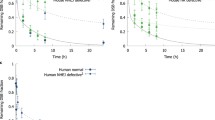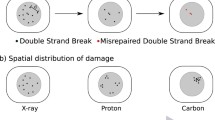Conclusion
Radiation pathology is a general term describing the damage that occurs in tissues after irradiation. After the very low doses, received by the normal working population, no major pathology is seen. There is a hazard of cancer induction if DNA damage that has been inflicted in an individual cell is repaired in such a way that the DNA remains intact but rearranged. This radiation carcinogenesis is however a low risk compared with many chemical carcinogens in the environment and in cancer chemotherapy.
The treatment of cancer by radiation is now commonly accepted as one of the most effective forms of treatment. It can kill tumour cells effectively, but the dose that can be given is limited by the normal tissues that are inevitably included in the beam. Cell function is maintained for some time even after very large doses. However normal tissues show a loss of function and structure because the proliferating subcompartment of each tissue is depleted as the radiation injured cells fail to divide and die. The time at which the cell deficit is detected varies from hours in some tissues to months or years in others. It depends upon the normal rate of cell turnover. The apparent sensitivity of each tissue therefore depends upon the time at which the assessment is made. Lung and kidney would appear very resistant at 1–3 months post irradiation, but would seem very radiosensitive at 6–12 months as their latent damage is expressed.
The ultimate expression of radiation pathology is the death of the whole animal as the essential organ function fails. The time of this death is only comprehensible if the time sequence and the proliferation kinetics of the target cells are taken into account. It must be recognised that it is initial damage to the clonogenic cells, not to the differentiated cells per se that is important.
Similar content being viewed by others
References
Aherne, W. A., Camplejohn, R. S., and Wright, N. A., An Introduction to Cell Population Kinetics. Pub. Edward Arnold, London 1977.
Alper, T., Fowler, J. F., Morgan, R. L., Vonberg, D. D., Ellis, F., and Oliver, R., The characterisation of the ‘Type C’ survival curve. Br. J. Radiol.35 (1962) 722–723.
Begg, A. C., McNally, N. J., Shrieve, D. C., and Kärcher, H., A method to measure the duration of DNA synthesis and the potential doubling time from a single sample. Cytometry6 (1985) 620–626.
Clausen, O. P. F., Thorud, E., Bjerknes, R., and Elgjo, K., Circadian rhythms in mouse epidermal basal cell proliferation. Variations in compartment size, flux and phase duration. Cell Tiss. Kinet.12 (1979) 319–337.
Cullen, B. M., Michalowski, A., and Walker, H. C., Correlation between the radiobiological oxygen constant, K, and the non-protein sulphydryl content of mammalian cells. Int. J. Radiat. Biol.38 (1980) 525–535.
Denekamp, J. The cellular proliferation kinetics of animal tumours. Cancer Res.39 (1970) 393–400.
Denekamp, J., Changes in the rate of repopulation during multifraction irradiation of mouse skin. Br. J. Radiol.46 (1973) 381–387.
Denekamp, J., Cell Kinetics and Cancer Therapy. Ed. W. C. Dewey. C. C. Thomas, Springfield, Illinois 1982.
Denekamp, J., Cell kinetics and radiation biology. Int. J. Radiat. Biol.2 (1986) 357–380.
Denekamp, J. and Fowler, J. F., Cell proliferation kinetics and radiation therapy, in: Cancer: A Comprehensive Treatise, vol. 6, pp. 101–138 Ed. F. Becker. Plenum, New York/London 1977.
Denekamp, J., Stewart, F. A., and Douglas, B. G., Changes in the proliferation rate of mouse epidermis after irradiation: continuous labelling studies. Cell Tiss. Kinet.9 (1976) 19–29.
Douglas, B. G., and Fowler, J. F., The effect of multiple small doses of X-rays on skin reactions in the mouse and a basic interpretation. Radiat. Res.66 (1976) 401–426.
Elkind, M. M., Han, A., and Volz, K. W., Radiation response of mammalian cells grown in culture. IV. Dose dependence of division delay and post-irradiation growth of surviving and non-surviving Chinese hamster cells. J. natl Canc. Inst.30 (1963) 705–721.
Folkman, J., Tumor angiogenesis factor. Cancer Res.34 (1974) 2109–2113.
Fowler, J. F., La Ronde — radiation sciences and medical radiology. Radiotherapy Oncology1 (1983) 1–22.
Fowler, J. F., Review: Total doses in fractionated radiotherapy —implications of new radiobiological data. Int. J. Radiat. Biol.46 (1984) 103–120.
Fowler, J. F., and Denekamp, J., Radiation effects on normal tissues, in: Cancer: A Comprehensive Treatise, vol. 6, pp. 139–176. Ed. F. Becker. Plenum, New York/London 1977.
Gratzner, H. G., Monoclonal antibody to 5-bromo- and 5-iodeoxyuridine: A new reagent for detection of DNA replication. Science218 (1982) 474–475.
Gray, J. W. (Ed.), Monoclonal antibodies against bromodeoxyuridine. Cytometry6 (1985) 501–662.
Gray, L. H., Conger, A. D., Ebert, M., Horney, S., and Scott, O. C. A.: The concentration of oxygen dissolved in tissues at the time of irradiation as a factor in radiotherapy. Br. J. Radiol.26 (1953) 638–648.
Howard, A., and Pelc, S. R., Synthesis of deoxyribonucleic acid in normal and irradiated cells and its relation to chromosome breakage. Heredity, Suppl. 6 (1953) 261–273.
Lesher, S., and Bauman, J., Cell kinetic studies of the intestinal epithelium: Maintenance of the intestinal epithelium in normal and irradiated animals. Natl Cancer Inst.30 (1969) 185–198.
Michalowski, A., Wheldon, T. E., and Kirk, T., Can cell survival parameters be deduced from non-clonogenic assays to normal tissues. Br. J. Cancer49 Suppl. VI (1984) 257–261.
Ohara, H., and Terasima, T., Variations of cellular sulphydryl content during cell cycle of HeLa cells and its correlation to cyclic change of X-ray sensitivity. Exp. Cell Res.58 (1969) 182–185.
Potten, C. S., and Hendry, J. H., Cell Clones: Manual of Mammalian Cell Techniques. Churchill Livingstone, Edinburgh 1985.
Quastler, H., and Sherman, F. G., Cell population kinetics in the intestinal epithelium of the mouse. Exp. Cell Res.17 (1959) 420–438.
Sinclair, W. K., Dependence of radiosensitivity upon cell age, in: Time and Dose Relationships in Radiation Biology as Applied to Radiotherapy, pp. 97–107. BNL Report 50203 (C-57) 1969.
Sinclair, W. K., N-ethylmaleimide and the cyclic response to X-rays of synchronous Chinese hamster cells. Radiat. Res.55 (1973) 41–57.
Steel, G. G., Cell loss as a factor in the growth rate of human tumours. Eur. J. Cancer3 (1967) 381–387.
Steel, G. G., Growth Kinetics of Tumours. Oxford University Press, Oxford 1977.
Stevens, G., Joiner, B., and Denekamp, J., Radioprotection by hypoxic breathing. Proc. 6th Conference on Chemical Modifiers of Cancer Treatment, pp. 20–21. Eds E. P. Malaise, G. E. Adams, S. Dische, and M. Guichard. Paris 1988.
Stewart, F. A., Soranson, J. A., Alpen, E. L., Williams, M. V. and Denekamp, J., Radiation-induced renal damage: the effects of hyperfraction. Radiat. Res.98 (1984) 407–420.
Thames, H. D., Withers, H. R., Peters, L. J., and Fletcher, G. H., Changes in early and late radiation responses with altered dose fractionation: implications for dose-survival relationships. Int. J. Radiat. Oncol. Biol. Phys.8 (1982) 219–226.
Wheldon, T. E., Michalowski, A. S., and Kirk, J., The effect of irradiation on function in self-renewing normal tissues with differing proliferative organisation. Br. J. Radiol.55 (1982) 759–766.
Withers, H. R., Regeneration of intestinal mucosa after irradiation. Cancer28 (1971) 75–81.
Withers, H. R., Thames, H. D., and Peters, L. J., Differences in the fractionation response of acutely and late-responding tissues. in: Progress in Radio Oncology II, pp. 287–296.Eds K. H. Karcher, H. D. Kogelnik and G. Reinartz. Raven Press, New York 1982.
Author information
Authors and Affiliations
Rights and permissions
About this article
Cite this article
Denekamp, J., Rojas, A. Cell kinetics and radiation pathology. Experientia 45, 33–41 (1989). https://doi.org/10.1007/BF01990450
Published:
Issue Date:
DOI: https://doi.org/10.1007/BF01990450




